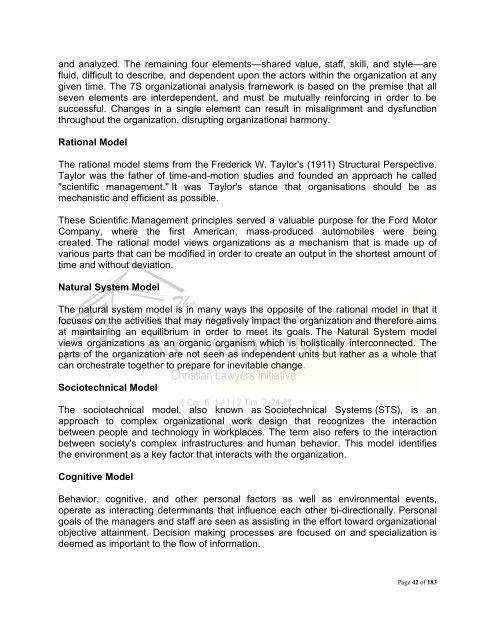The 508(c)(1)(a) Initiative Workshop
The 508(c)(1)(a) Initiative Workshop
The 508(c)(1)(a) Initiative Workshop
You also want an ePaper? Increase the reach of your titles
YUMPU automatically turns print PDFs into web optimized ePapers that Google loves.
and analyzed. <strong>The</strong> remaining four elements—shared value, staff, skill, and style—are<br />
fluid, difficult to describe, and dependent upon the actors within the organization at any<br />
given time. <strong>The</strong> 7S organizational analysis framework is based on the premise that all<br />
seven elements are interdependent, and must be mutually reinforcing in order to be<br />
successful. Changes in a single element can result in misalignment and dysfunction<br />
throughout the organization, disrupting organizational harmony.<br />
Rational Model<br />
<strong>The</strong> rational model stems from the Frederick W. Taylor's (1911) Structural Perspective.<br />
Taylor was the father of time-and-motion studies and founded an approach he called<br />
"scientific management." It was Taylor's stance that organisations should be as<br />
mechanistic and efficient as possible.<br />
<strong>The</strong>se Scientific Management principles served a valuable purpose for the Ford Motor<br />
Company, where the first American, mass-produced automobiles were being<br />
created. <strong>The</strong> rational model views organizations as a mechanism that is made up of<br />
various parts that can be modified in order to create an output in the shortest amount of<br />
time and without deviation.<br />
Natural System Model<br />
<strong>The</strong> natural system model is in many ways the opposite of the rational model in that it<br />
focuses on the activities that may negatively impact the organization and therefore aims<br />
at maintaining an equilibrium in order to meet its goals. <strong>The</strong> Natural System model<br />
views organizations as an organic organism which is holistically interconnected. <strong>The</strong><br />
parts of the organization are not seen as independent units but rather as a whole that<br />
can orchestrate together to prepare for inevitable change.<br />
Sociotechnical Model<br />
<strong>The</strong> sociotechnical model, also known as Sociotechnical Systems (STS), is an<br />
approach to complex organizational work design that recognizes the interaction<br />
between people and technology in workplaces. <strong>The</strong> term also refers to the interaction<br />
between society's complex infrastructures and human behavior. This model identifies<br />
the environment as a key factor that interacts with the organization.<br />
Cognitive Model<br />
Behavior, cognitive, and other personal factors as well as environmental events,<br />
operate as interacting determinants that influence each other bi-directionally. Personal<br />
goals of the managers and staff are seen as assisting in the effort toward organizational<br />
objective attainment. Decision making processes are focused on and specialization is<br />
deemed as important to the flow of information.<br />
Page 42 of 183
















